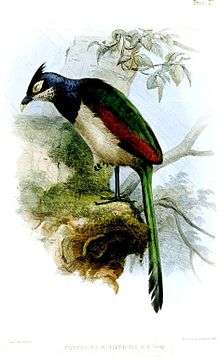Rufous-winged ground cuckoo
The rufous-winged ground cuckoo (Neomorphus rufipennis) is a species of cuckoo in the family Cuculidae. It is found in humid primary forests in northern Brazil, Guyana, Venezuela, and Colombia. At 50 centimetres (20 in) in length, it is the largest South American cuckoo together with the other members of the genus Neomorphus. It was named in 1849.
| Rufous-winged ground cuckoo | |
|---|---|
 | |
| Illustration based on specimen. The skin around the eyes is red in living individuals | |
| Scientific classification | |
| Kingdom: | Animalia |
| Phylum: | Chordata |
| Class: | Aves |
| Order: | Cuculiformes |
| Family: | Cuculidae |
| Genus: | Neomorphus |
| Species: | N. rufipennis |
| Binomial name | |
| Neomorphus rufipennis (Gray, 1849) | |
Description
The adults are about 50 centimetres (20 in) in length. They typically have a semi-shiny dark-green feather on the back. The crest is a glossy black with a purple undertones. Its throat is ash-white to gray but some have been seen with black coloring.[2] Its wings are dark red and the belly is distinctly scaled.[3]
Ecology
Diet
Its diet consists of grasshoppers, crickets and spiders. Often its heard making loud bill-snaps while its song consists of a single hooting note.[3] It's capable of swiftly moving across the forest floor. Most aspects of the rufous-winged ground cuckoo's life are unknown.[3]
Reproduction
Most of the birds breading habits remain unknown. The eggs are yellowish-white and about 40 millimetres (1.6 in) long and 31 millimetres (1.2 in) around.[2] Both sexes have been observed caring for the young.
Conservation
The population has not be recorded. Because the bird has a very wide habitat and range, it is not considered vulnerable. Even though its population is estimated to be trending downward. It is expected to decline less than 25% over the next 13 years.[4] It is a restless and solitary bird that spends a majority of its time running along the ground.
References
- BirdLife International (2012). "Neomorphus rufipennis". IUCN Red List of Threatened Species. 2012. Retrieved 26 November 2013.CS1 maint: ref=harv (link)
- "Rufous-winged Ground-cuckoo (Neomorphus rufipennis)". www.hbw.com. Retrieved 2017-09-16.
- "Rufous-winged Ground-Cuckoo - Introduction | Neotropical Birds Online". neotropical.birds.cornell.edu. Retrieved 2017-06-05.
- "Neomorphus rufipennis (Rufous-winged Ground-cuckoo, Rufous-winged Ground Cuckoo, Rufous-winged Ground-Cuckoo)". IUCN Red List of Threatened Species. Retrieved 2017-09-16.
